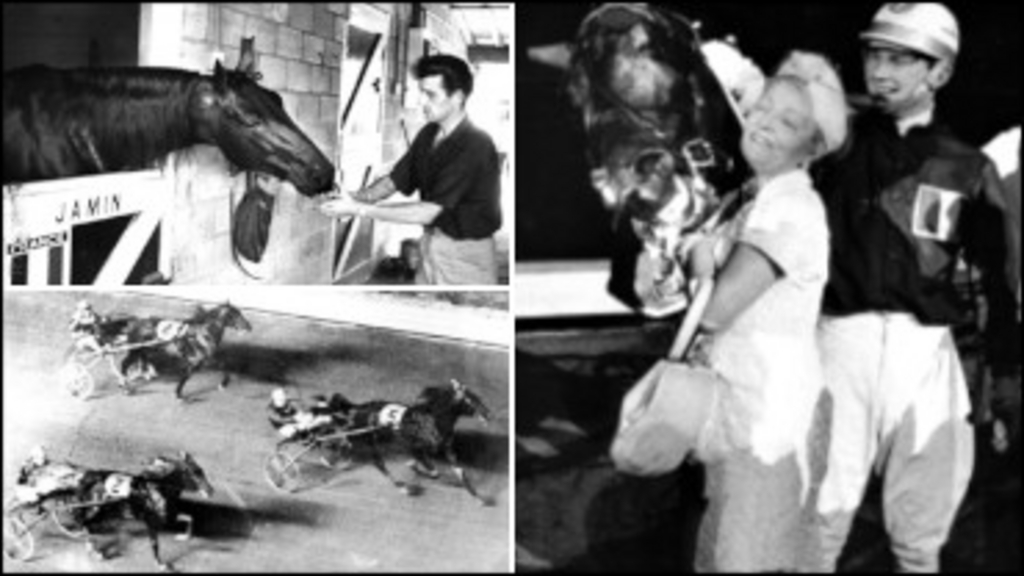
 In this week's edition of Rewind Robert Smith takes readers back in time a little over 60 years to recall a rather unusual and interesting story involving one of the great International performers of that period in time.
In this week's edition of Rewind Robert Smith takes readers back in time a little over 60 years to recall a rather unusual and interesting story involving one of the great International performers of that period in time.
Back on August 1, 1959, the first ever International Trot was held at Roosevelt Raceway. Although this race was fairly recent in its planning, the idea of inviting the top trotters from foreign countries to compete in North America had been around for a long time. Unfortunately the political climate in a number of countries as well as a phenomenon called "The Cold War" had previously rendered this possibility impossible. The time had now arrived and it was an event of huge proportions.
Leading up to the race time, horses began arriving at Roosevelt Raceway on Long Island, N.Y. Whether it was a matter of quarantine or just to get the horses climatized after the long journey to North America I am not just certain. After all there were horses coming from France, Italy and Sweden and yes even Canada.
Lew "Tootie" Barash, the great promoter at Roosevelt, had lined up an outstanding field of trotters for this event. They literally came from every area of the globe and represented the best aged trotting talent in all of the world of harness racing. Representing the United States was Trader Horn; Philip Frost was Canada's entrant; Norway sent Jens Protector, while Germany was represented by Ivancourt; Italy had two entrants, Tornese and Icare IV and France sent their stalwart, Jamin. There was even an entrant from New Zealand by the name of Adept.
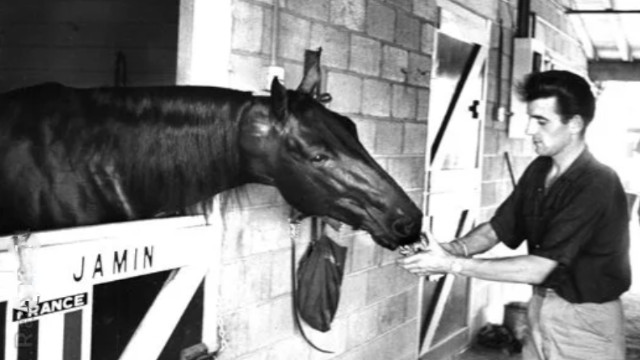
Jamin gets a special treat from his trainer and driver Jean Riaud while stabled at Roosevelt Raceway
When France's top trotter Jamin arrived at the New York airport he brought a rather unusual item as part of his equipment. It was a goodly supply of artichokes which for some time had been a vital part of the horse's daily diet. Yes, artichokes! While most horses might survive on hay and oats and a few other specialties, this great trotter loved to eat artichokes. Jamin's trainer and driver Jean Riaud explained just how this rather strange choice of food came about. “I was eating artichokes one day in France, where they are plentiful. I kept the tails and fed them to Jamin. He liked them so much I began buying them for him. They were good for him too.”
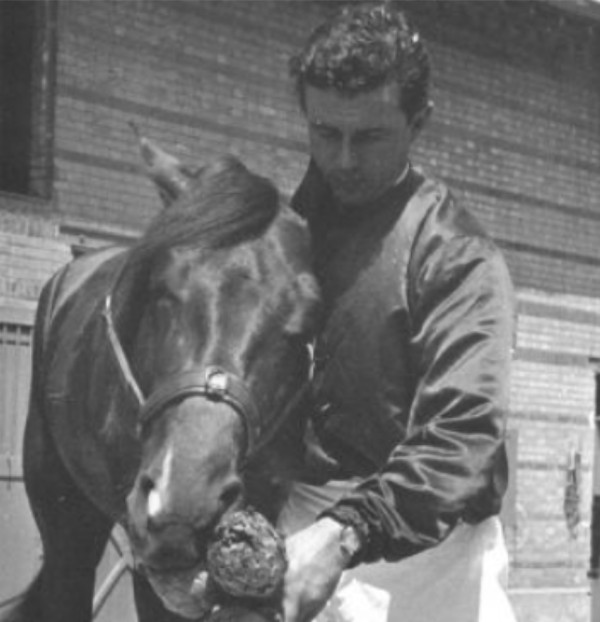
Jamin munches on an artichoke
Upon arriving in the U.S. his food supply of artichokes was impounded by the Department of Agriculture. Perhaps typical of most affairs involving governmental agencies, the artichokes inexplicably got lost. This soon set the stage for a series of events that was quite unexpected and also fairly widespread. Nick Grande was the public relations director at Roosevelt Raceway and he along with Joe Goldstein put out a national disaster call.
Apparently Jamin would not eat, he reportedly began to lose weight and according to the publicity people the question was being asked... could he starve and was he lying at death's door? So humane societies, Boy Scouts, Girl Scouts, storekeepers and just private citizens responded. News stories flashed across the country via AP and UPI; soon everyone that knew the story was scouring the land for the life-saving delicacy. The search locally came up completely dry. Artichokes just weren't in season along the Atlantic shores.
But in far off Monterey, California, the Peninsula Herald's managing editor Ted Durein petitioned grower Eugene Boggiatto for help. In turn Mr. Boggattio enlisted the aid of the California artichoke and vegetable growers' association. They soon assembled a shipment of 120 pounds of the now famous item which was grown in Castroville, Cal. Their destination was Idlewild Airport, not far from Roosevelt and the present home of the "starving" Jamin. The following is an excerpt from a Hoof Beats article that described the next episode of this by now bizarre story.
"Waiting for the touchdown of the mercy plane was a horde of newsmen and photographers, a delegation of Raceway officials and, oh yes, a helicopter to hurry the artichokes to Jamin's stall. It all worked. It was a great publicity stunt and a fitting send off for the inaugural International Trot."
When race day finally arrived the "artichoke connection" had been exploited to the fullest extent. In some ways it had become almost as important as the race itself. Jamin said to be energized by his infusion of artichokes was indeed the talk of the race but still not the betting favourite; that honour went to the U.S. entrant Trader Horn and driver Billy Haughton. Some observers felt that the extra distance of 1 1/2 miles worked against the U.S. horse while Jamin was accustomed to the extra travel time.
The race had no place for upsets and as envisioned by many, Jamin emerged as the winner. In second spot was Tornese (Italy) with the favoured U.S. entrant Trader Horn taking down the show spot. Philip Frost representing Canada finished seventh. It was a great and memorable race attended by over 48,000 fans. It attracted eight champions from seven nations and paved the way for several more great contests in the years following.
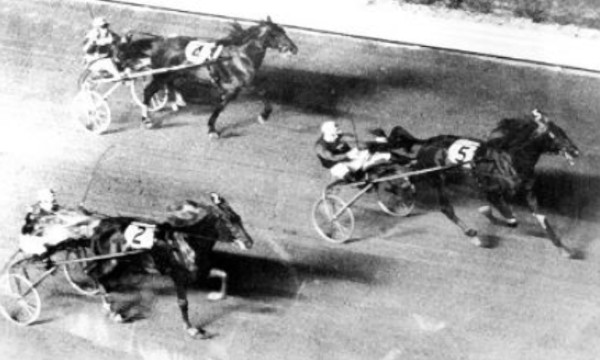
Jamin held on to victory in front of a crowd of 48,0000 spectators, with the Italian horse Tornese in second by half a length and betting favourite Trader Horn, the American entry, in third
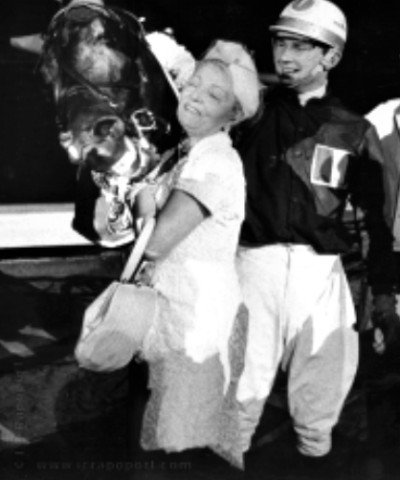
Jamin and owner Mrs. Leon Oiry-Roederer of Paris, France appear in the winner's circle along with driver Jean Riaud following their great victory at Roosevelt Raceway
Apparently Jamin's supply of artichokes continued to "flow" as he stayed on U.S. soil for much of the balance of the year. Riaud and Jamin made several more track appearances including a couple of time trials, at both Springfield and DuQuoin. In September they won another $50,000 race at Roosevelt that was actually won by Senator Frost. A disqualification for a lapped-on break moved the French horse into the lucrative win. Late in the fall they went out to California and won a division of the $25,000 American Classic. At year end Jamin listed just five starts in North America but total earnings of $70,000. I doubt that too many other horses won that kind of money per start 62 years ago. His lifetime earnings were listed at $164,730 at the end of 1959 which would amount to about $1,500.000 in today's dollars.

Jamin was a six-year-old at the time of his heroics in the U.S. and was well loved wherever he appeared
Quote For The Week: "Take a moment to treasure the moment."
Who Is It?
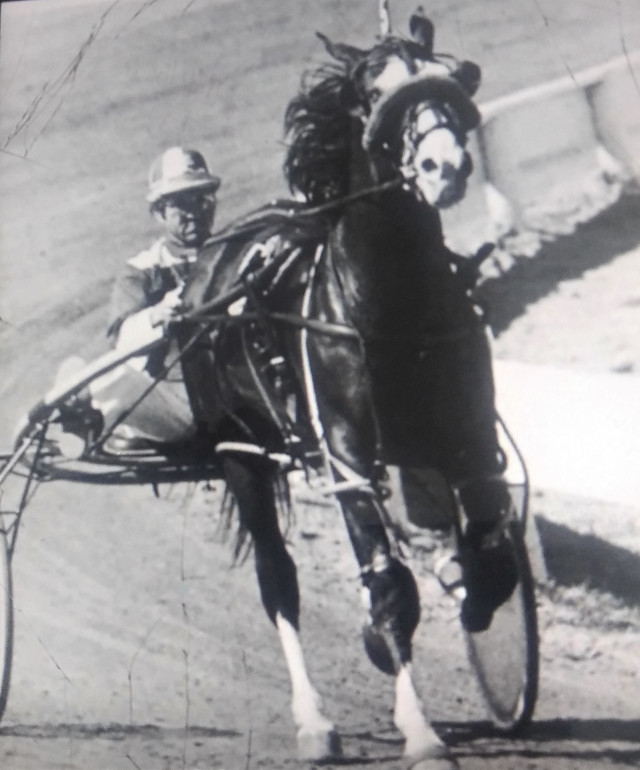
Can you name the driver shown in the picture above? He was a good one and if you recognize him let us know.
Who Else Is It?
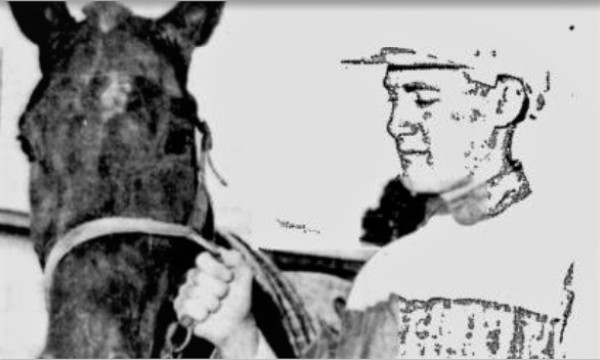
Who is this fellow as he appeared in this 1965 photograph while racing in Montreal? If you can put a name on him let us know who you think it is.
Make sure to stay tuned during the coming week to see the correct answers.


This week's pictures were
This week's pictures were again no match for our expert readers . The correct answers were as follows:
Top picture was driver Bruce Nickells behind Dapper Baron.
The "Who else is it?" picture was Brian Webster during his driving days in a picture that appeared in the Montreal Gazette in a day when a lot of attention was paid to Montreal's two big tracks.
In a final note on the artichoke story, the famed publicity man Joey Goldstein was truly "a legend in his own time" and orchestrated this story as well as many more in the New York City sports scene. He lived to the age of 81 and passed away in 2009. There is a race held in his memory each year as part of the NYSS series. He was elected a member of the Harness Racing Hall of Fame.
I think who else is it is
I think who else is it is Brian Webster.
Jamin's need for artichokes
Jamin's need for artichokes and the promotion was the brainchild of Joey Goldstein who was the greatest PR man and promoter in the history of Harness Racing.
looks alot like Brian Webster
looks alot like Brian Webster
Bruce Nickells. Brian Webster
Bruce Nickells. Brian Webster
It looks like Del Insko, but
It looks like Del Insko, but I can't tell if he has a toothpick in his mouth (which was his trademark).
Who is it #1 - Del Insko?
Who is it #1 - Del Insko?
The horse with the white face
The horse with the white face in the photo is Dapper Baron (he was deaf) a son of Baron Hanover who stood stud in Ohio--the driver is Bruce Nickells (whose brother Dennis just passed away this week).
Who is it? Bruce Nickells
Who is it?
Bruce Nickells driving Dapper Baron
DR Ackerman
Bruce Nickels, just a guess
Bruce Nickels, just a guess Reg Boily. Thanks Robert!
Del Insko
Del Insko
The 1st picture is Dapper
The 1st picture is Dapper Baron & Bruce Nickells.